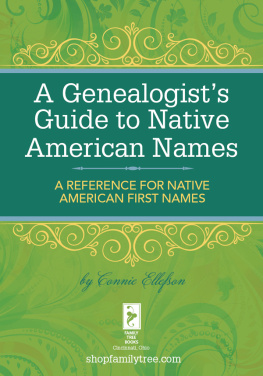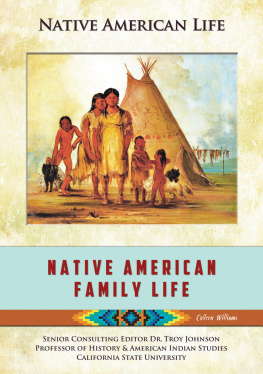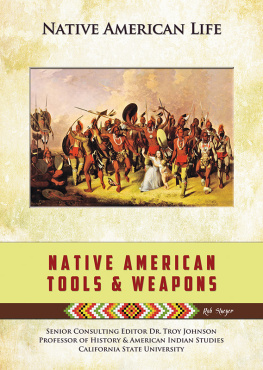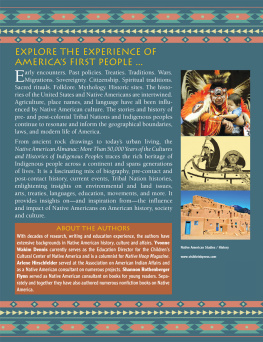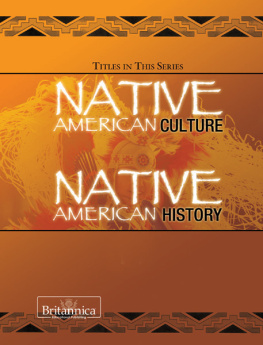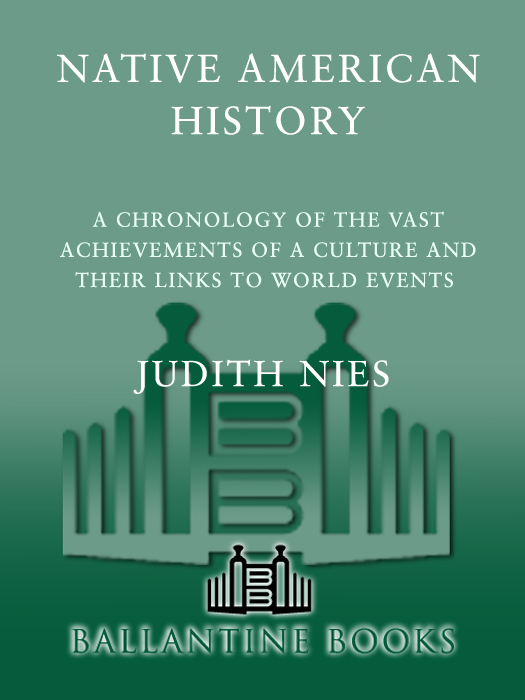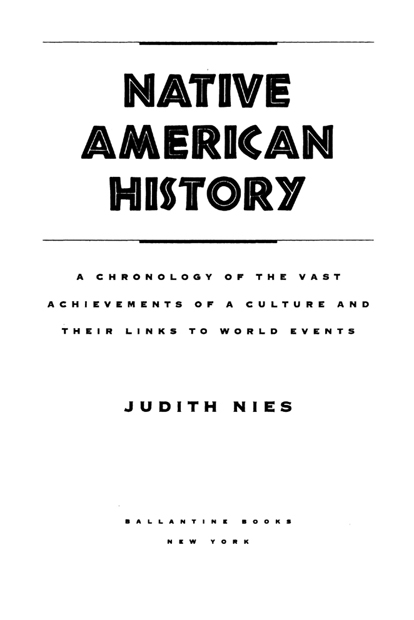ALSO BY JUDITH NIES
Seven Women: Portraits from the American Radical Tradition
American Militarism
(co-edited with Erwin Knoll)
War Crimes and the American Conscience
(co-edited with Erwin Knoll)
A Ballantine Book
Published by The Random House Publishing Group
Copyright 1996 by Judith E. Nies
All rights reserved.
Published in the United States by Ballantine Books, an imprint of The Random House Publishing Group, a division of Random House, Inc., New York, and simultaneously in Canada by Random House of Canada Limited, Toronto.
Ballantine and colophon are registered trademarks of Random House, Inc
www.ballantinebooks.com
LIBRARY OF CONGRESS CATALOGING-IN-PUBLICATION DATA
Nies, Judith, 1941
Native American history / by Judith Nies. 1st ed.
p. cm.
Includes bibliographical references.
eISBN: 978-0-307-81405-0
1. Indians of North AmericaHistory. 2. Indians of North AmericaSocial life and customs. I. Title.
E77.N56 1996
970.00497dc20 96-32659
v3.1
Events do not happen in categorieseconomic, intellectual, militarythey happen in sequence. When they are arranged in sequence as strictly as possible cause and effect that may have been previously obscure, will often become clear, like secret ink.
BARBARA W. TUCHMAN
PRACTICING HISTORY: SELECTED ESSAYS

TABLE OF CONTENTS

A CKNOWLEDGMENTS
My research has been greatly aided by many people who pointed me in directions I might not have thought to go. My thanks to many of the members of the Harvard University Native American Program (19911993) whose lectures, discussions, and perspectives informed and enlightened me in ways I was not aware of at the time. Since part of the historical record exists in photographs rather than documents, my thanks to Andrew Connors at the Museum of American Art and Paula Fleming at the National Anthropological Archives in Washington, D.C. Special thanks to Sarah Flynn for help with photo research. Reference librarians have been wonderfully informative and I thank the Skidmore College Library, the Tozzer Library at Harvard University (Elizabeth Cherniack, Morris Fry, Gregory Finnegan), the Houghton rare book library at Harvard University, the Boston Public Library, the Schlesinger Library at Radcliffe College, the North Cambridge Public Library (Jessica Rabban), the Arizona State University Library Archives and the Brigham Young University Archives. Special thanks to Harvard doctoral candidates Gabrielle Tayac of the Piscataway community in Maryland and Athabascan Phyllis A. Fast of Alaska, now a professor at the University of Alaska, Fairbanks, who helped me conceptualize the beginning and end of this chronology, and advised me on matters of terminology and concepts. I take full responsibility for all mistakes. I must also thank Charlotte Sheedy and Regula Noetzli for their vision and encouragement. My thanks also to the Bunting Institute of Radcliffe College and the Yaddo Corporation for providing time and support.

I NTRODUCTION
History is context. We choose our history by selecting certain events to include in the narrative. Those events take their meaning in relation to other events. And these narratives make up the myths of our culturemyths that are changing all the time. My idea for a chronology of Native American history grew out of the paradigm shift that resulted from the quincentenary celebration of Columbuss arrival in the western hemisphere in 1492. Like many people expecting a lively celebration of Columbuss heroism, courage, and mythic vision, my imagination was captured instead by the view from the shore. The point of view presented by indigenous peoples was one of great native contributions and great European injustices. Their perspective changed the narrative of time and challenged the conventional myths of the Americas.
In colorful contradiction to centuries of national Columbus holidays and mainstream history texts, indigenous peoples throughout the hemisphere launched demonstrations to publicize the historical reality of the Arawak Indians and Columbuss genocidal search for gold. At the time Columbus landed on the island he dubbed Hispaniola in 1492 there were an estimated 30 million people in Mexico and the Caribbean Islands (Columbuss brother counted over one million male inhabitants in the Dominican Republic in the census he conducted to determine how many adult males should be bringing in gold for tribute) and another estimated 50 million in the U.S., Canada, and South America, many of whom lived in highly complex cultures with sophisticated knowledge of astronomy, agriculture, metalworking, weaving, geography, measurement of time.
America has been notably uninterested in the people who lived here before the European invasions of the fifteenth and sixteenth centuries. In the year A.D. 750, when London was still historically insignificant, the sixth-largest city in the world (including Constantinople and Alexandria) was Teotihuacn in the Mexico Valley, near what today is Mexico City. In the year 800 the Hohokam were irrigating the land that today is Phoenix and building seven-story apartment buildings at the same time the former barbarian Charlemagne was being crowned emperor of the Holy Roman Empire (which, to quote Voltaire, was neither holy nor Roman). The largest pyramid outside of Egypt was (and can still be seen today) in Cahokia, Illinois, near the confluence of the Missouri, Illinois, and Mississippi Rivers, a remnant of the great Mississippian civilization. The Mississippians left thousands of temple mounds and geometric earthworks along the lands of the Mississippi River valleys in settlement patterns so dense that when the Arkansas Archaeological Society recently put all 21,700 sites on a computerized map it showed a thoroughly settled state by the 1300s. Albert Gallatin, Jeffersons secretary of the treasury, was the first to write about the great architectural marvels of the Mississippi Valley and the mound builders. He was joined by Henry Brackenridge, an early explorer of the Ohio Valley as far south as Louisiana. An immense population has once been supported in this country, he observed about the thousands of geometrically arranged mounds that laced the South. But these were colonial Americans intent on land acquisition. Knowledge and exploration were in the service of real estate. American mythology required a virgin continent and a vanished race. By 1950 over 90 percent of the archaeological marvels written about by Gallatin and Brackenridge had been declared valueless and lost to highways, railroads, farmlands, real estate development, shopping malls.
By 1992, however, a parallel narrative had been constructed by Native American writers. Their refusal to venerate Columbuss heroism and discovery raised a lot of questions: How can you discover a hemisphere that has over 70 million people? Why couldnt the European Christians see the Native peoples as fellow human beings? Is it true that Pilgrims in Plymouth, Americas first permanent colony, survived their first winter only because of the instruction of an English-speaking Indian named Squanto? Did the principles of the Iroquois confederacy influence the drafters of the U.S. Constitution? How did the agricultural products of American Indianscorn, beans, squashenrich the diet and health of Renaissance Europe? Were there great urban centers in America long before London or Paris were founded? Ultimately, the sputtering of Columbuss historic flame was best symbolized by the fate of the modern replicas of his boats. Instead of making triumphant entries into dozens of American harbors, the


